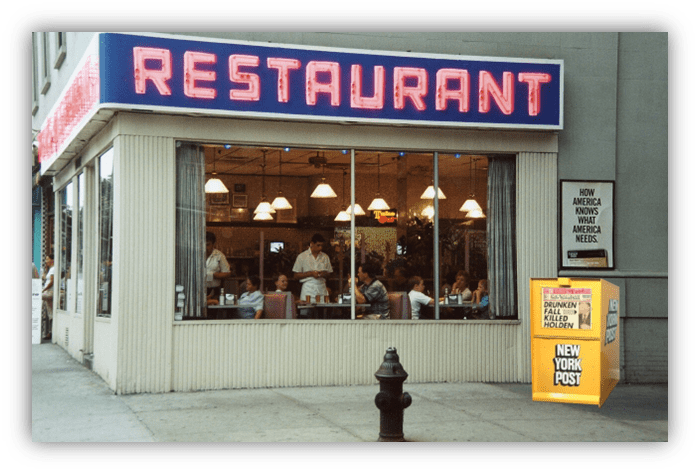We love Sabrina Carpenter’s “Espresso.” We really do.
But to those who maintain that it’s the earworm GOAT, we’ll just say:

Hold our coffee mug:
And remember the first time that you heard this:
That, of course, is the first few seconds of the popular remix of Suzanne Vega’s “Tom’s Diner.” So catchy, right? That was my initial reaction when I first heard the song in 1990.
But on further reflection: if I’ve simply relegated this recording to just a simple “earworm” status? Then I’m selling it short. The myriad layers and strange origins behind this composition and its variated recordings are a tale of songwriting, discovery, interpolation, technology, and ultimately, respectful tribute..
…With a little bit of puzzle-solving work on the side. The story begins, back in…
1987: The Original Recording

“Tom’s Diner”
Suzanne Vega
Released in 1987 as the opening track on her second album, Solitude Standing, “Tom’s Diner” was a departure from the folk-oriented music that had characterized Vega’s earlier work. A two-minute minimalist, a cappella song, the track features a clear, intimate voice – and nothing more.
The lyrics tell a mundane yet vivid story of a woman observing people in a diner – looking out the window, reading the paper, and passing the time in an almost disturbingly routine way. There is a quiet curiosity in how she observes and reports; a brief snapshot into their lives without judgment.
The song’s lyrics are deceptively simple, but rich with imagery. Vega’s sparse arrangement allows her voice to take center stage.

If you’re only familiar with the poplar remix version, you will immediately notice that something seems to have gone missing, at both the beginning and in-between the verses.
“Tom’s Diner” was released as the follow-up single to Vega’s Number 3 hit, “Luka.” While it did manage to make it to Number 26 in Ireland, the original “Tom’s Diner” only hit Number 58 on the UK Official Charts.

In the States, it failed to crack the Billboard Hot 100. And that was the end of the story.
Until about two and a half years later, in…
1990: The Remix
In 1990, two British electronic music producers from Bath, England were experimenting with different sounds in an attempt to create a serviceable dance track.
Nick Batt and Neal Slateford, working together as a duo called DNA, liked the idea of adding beats to a singular, lone vocal. Slateford remembered the Suzanne Vega recording and suggested that they add synthesizer and piano layers on top of beats lifted from Soul II Soul’s “Keep On Movin’.”
Nick Batt:

“We sent it to a mate who was a rep in London and he took it around the shops. I went away for the weekend and came back to a phone full of messages. Everyone was talking about the track.”
“[BBC] Radio 1 even broke its policy of not playing bootlegs, which is all it was at that point. Then the track became massive. We were only kept off Number One by the Teenage Mutant Ninja Turtles!”
As you would imagine, Suzanne Vega had a reaction about the repurposing of her 1987 recording.

“Three years later, I heard that two young English guys called DNA had put a beat to it – and I cringed.“
“I’d just had a big hit with “Luka“, which – unfortunately, despite its dark subject matter, child abuse – lent itself to all sorts of parodies and covers, most of which I hated. I feared more of the same. But to my great relief, I loved what DNA had done.”
Ironically, by giving Vega a second major chart score, DNA themselves became a one-hit wonder.
The DNA version of “Tom’s Diner” achieved significant chart success, reaching heights on dance, alternative, and pop music charts around the world.

The remix went to Number Five on the Billboard Hot 100 – and thanks to Leonardo, Donatello, Raphael and Michelangelo, just missed top spot on the UK Official Charts, topping out at Number Two. It became a key part of the growing electronic music movement, with many people regarding it as a landmark in the genre of ambient house music.
Unfortunately, DNA made virtually nothing for their work.

Slateford and Batt initially reached out to have their remix properly licensed. But A&M, Vega’s record label, never responded. Emboldened by the reaction to their creation, they released their version anyway – illegally so.
After BBC Radio played the song on the air, A&M threatened to sue the pair, so DNA was forced to sign away all rights to the remix for less than $8,000. And that was the end of the story. Until…
1992:

“Tom’s Diner”
The Mother Of The MP3
In the late 1980s and early 1990s, the music industry was undergoing a massive technological transformation.
One of the central developments was the creation of the MP3 format. MPEG-1 Audio Layer 3, or MP3 for short, is a digital audio encoding format that uses compression to reduce the size of audio files, allowing for practical storage and sharing.

The MP3 format revolutionized the way music was distributed and consumed, paving the way for the rise of digital music services like Napster, Limewire, and Kazza.
At the Fraunhofer Institute in Germany in the 1990’s, audio scientist and engineer Karlheinz Brandenburg was hard at work developing the MP3 audio compression scheme.

“I was ready to fine tune my compression algorithm and somewhere down the corridor a radio was playing “Tom’s Diner.” I was electrified. I knew it would be nearly impossible to compress this warm a cappella voice.”
Brandenburg and his team of researchers concurred that the clarity and simplicity of the original track made it the ideal test case for evaluating the efficiency of the new technology. After painstaking work through about 3000 listens, they solved the problems, and determined a proper mathematical solution. “Tom’s Diner” became the patient-zero, gold-standard sonic reference when testing and defining the new technology.
Vega herself was not initially aware of the song’s role with MP3 development.

Flattered that her song had been used in such a pioneering way, she was also somewhat bemused by the fact that it had become so closely associated with a technological breakthrough.
So it could be argued that ultimately, “Tom’s Diner” isn’t just a song – it’s also a milestone marker between analog and digital.
Vega continued to embrace the unlikely success and longevity of her creation.

She produced a compilation record of different versions of the song.
While the song’s production history and technological significance are fascinating, there is another aspect of “Tom’s Diner” that continues to intrigue fans.
Their question? Is there a specific date that the narrator is sitting in the diner?
Vega wrote the song based on a comment by a friend, talented New York based photographer Brian Rose.

Rose once mentioned to Vega that he sometimes felt as if “he saw his whole life through a pane of glass, and like he was the witness to a lot of things, but was never really involved in them.”
She attempted to think and write in this fashion while sitting at the very real spot where the Seinfeld fictional coffeeshop exteriors were shot:

At the corner of West 112th Street in Manhattan.
While Vega has never confirmed the specific date, there are a few fan theories that attempt to connect it to real-world events. While some point to vagaries in Vega’s “horoscopes” and “funnies” lines, there is one larger clue that likely points to a spot on the calendar:

In a 2008 interview, Vega confirmed that William Holden was the actor whose death she had read about, and had inspired the line in the song. If we search for a newspaper record about all of this, we can see that his death became public on a certain day:
The very day that we perhaps imagine ourselves…

… sitting in the morning
at the diner on the corner
while we’re waiting at the counter.
So, if you are so inclined:

Join us for a coffee, don’t mistakenly pour the milk, and let’s all appreciate Suzanne, Nick & Neal, Karlheinz, William Holden, and all of the characters that weave in and out of Tom’s Diner:

Today, November 18.







Good work… for your next trick, can you work out the date that Stevie Wonder called to say he loved you?
And just to be a completist dofus, here is the TMNT song that kept “Tom’s Diner” off the Number One spot!
https://www.youtube.com/watch?v=JOQPp1Yvtm8
Great stuff! I loved the DNA version of the song and was fascinated with all of the random people being observed and the detail in which the seemingly inconsequential events taking place were described. It was like nothing I had heard before. I knew the cover was a bootleg but didn’t know or had forgotten that the original was a capella with just her lone voice. That was a bold move releasing it as a single. And I definitely didn’t know that it was instrumental in the development of the mp3. Very cool.
Regarding the actor mentioned in the song, I always assumed it was a minor player or character actor type. Finding out today that it was William Holden, a very famous actor who starred in many beloved films and was still relevant just five years before, as one of the leads in Network, is throwing me off. I now have to question how Suzanne’s narrator could not have known who William Holden is and am starting to think harsh thoughts about said narrator.
Not something I expected to be doing today, but tnocs will do that to ya.
At the risk of lowering your opinion of me, I didn’t know William Holden by name or face when I looked him up. But I have seen that dance scene from Picnic with Kim Novak, and so I did in fact know him.
You’re probably a bit younger than the narrator would have been in the song, so,no, I wouldn’t have the same expectations.
If Network was too arty for the narrator, there was Damien: Omen II, in which William Holden held the lead role. Maybe the narrator majored in Comparative Literature and didn’t have time for movies. She missed out. Network is spoken about in hushed tones by many.
Yes, most certainly. I was too young to see it, but I remember the commercials scaring the pants off of me with that crow.
Great work mt. I expect Tom’s Diner day to be included on all calendars and diaries going forward.
Nick Batt isn’t wholly correct that dna were only kept off the top spot by Teenage Mutant Ninja Turtles. That is true of its first two weeks at #2 but the following week they finally outsold the turtles only to be overtaken and left stuck in the runners up spot by legend of children’s TV: Timmy Mallett (actually his real name) under the guise of Bombalurina with the abomination of Itsy Witsy Teeny Weeny Yellow Polka Dot Bikini. And 14 year old JJ thought the turtles were bad.
dna surprisingly aren’t an actual one hit wonder here. Though they may as well be for all anyone remembers of them.
In a left turn the follow up to Tom’s Diner was La Serenissima, covering a piece by Rondò Veneziano, an Italian chamber orchestra. That reached #34.
https://youtu.be/wGatZyuzGSA?feature=shared
In 1992 it was a more straightforward dance rework of Sharon Redd’s Can You Handle It, reaching #17.
https://youtu.be/LwI4sTewuDg?feature=shared
I found Solitude Standing to be a disappointment after Vega’s brilliant first album, and the downward trend has mostly continued unabated in the years since.
Oof. Not the biggest Vega stan around, but the title track remains a madeleine of that time frame for me. Now I’m off to listen to her debut.
I had forgotten that “Tom’s Diner” was the test song for the MP3. It’s a nice bit of music tech trivia.
As a songwriter, I have to ask myself why I didn’t think to write a similar song. Of all the times I’ve sat in a restaurant observing people, I never thought about writing it down. Well, there’s another gold record I don’t have.
Great work, mt58!
As you might expect, this track will be referenced again soon, though not nearly as thoroughly or well. Nice job, mt!
I don’t have a lot to add, other than to say I really enjoyed this deep dive on Tom’s Diner.
I can’t be the only one who remembers in 1994 when Nick at Nite interpolated the theme for the TV show “I Dream of Jeannie” with “Tom’s Diner” for this delectable promo of the series, can I? https://www.youtube.com/watch?v=QnyjsAcggfg